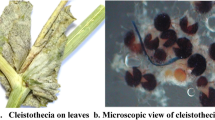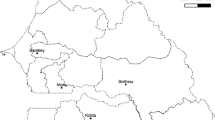Abstract
Erysiphe pisi, Erysiphe baeumleri and Erysiphe trifolii cause powdery mildew disease in garden pea. So far, three genes er1, er2 and Er3 imparting resistance against E. pisi have been reported in pea. The E. pisi isolate used in this study, Ep01 (GenBank Accession No. KM096758) was identified using the internal transcribed spacer sequence of the ribosomal DNA region. Testing of garden pea germplasm lines and cultivars against E. pisi pathogen under green house conditions revealed varying levels of resistance. The resistant control lines JI2302, JI2480 and P660-4 with reported resistance genes er1, er2 and Er3 respectively showed significant levels of resistance to the E. pisi isolate, Ep01 while the susceptible control lines, Messire and Lincoln showed significant levels of susceptibility. Out of the forty six pea lines (including the control lines) tested, three lines were found to be highly resistant, three lines were resistant, eighteen lines were moderately resistant, twelve were moderately susceptible, six were susceptible and four lines were highly susceptible. The molecular screening using SCAR markers for er1 gene, Sc-OPO-181200, Sc-OPE-161600, ScOPX 04880 and ScOPD 10650 did not lead to identification of er1 gene due to lack of expected amplification with Sc-OPE-161600 and Sc-OPO-181200 while no polymorphism was observed between resistant and susceptible controls with ScOPX 04880 and ScOPD 10650. The SCAR marker for er2 gene, ScX17_1400 led to identification of twenty four lines that may be carrying er2 gene while SCAR markers for Er3 gene, SCW4637 and SCAB1874, helped identify four lines as potential sources of Er3 gene.



Similar content being viewed by others
References
Attanayake RN, Glawe DA, McPhee KE, Dugan FM, Chen W (2010a) Erysiphe trifolii—a newly recognized powdery mildew pathogen of pea. Plant Pathol 59:712–720
Attanayake RN, Dugan FM, Chen W, Glawe DA, McPhee KE (2010b) Potential alternative hosts for the pea powdery mildew pathogen, Erysiphe trifolii. Pisum Genetics 2:18–20
Bharadwaj SS, Sharma SL (1984) Field evaluation of mildew-sides against powdery mildew of pea in Himachal Pradesh. Indian J Pl Pathol 2:103–105
Ek M, Eklund M, von Post R, Dayteg C, Henriksson T, Weibull P, Ceptillis A, Issac P, Tuvesson S (2005) Microsatellite markers for powdery mildew resistance in pea (Pisum sativum L.). Hereditas 142:86–91
Fondevilla S, Torres AM, Moreno MT, Rubiales D (2006) Macroscopic and histological characterization of genes er1 and er2 for powdery mildew resistance in Pea. Eur J Plant Pathology 115:309–321
Fondevilla S, Torres AM, Moreno MT, Rubiales D (2007) Identification of a new gene for resistance to powdery mildew in Pisum fulvum, a wild relative of pea. Breed Sci 57:181–184
Fondevilla S, Rubiales D, Moreno MT, Torres AM (2008) Identification and validation of RAPD and SCAR markers linked to the gene Er3 conferring resistance to Erysiphe pisi DC in pea. Mol Breed 22:193–200
Fondevilla S, Cubero JI, Rubiales D (2010) Confirmation that the Er3 gene, conferring resistance to Erysiphe pisi in pea, is a different gene from er1 and er2 genes. Plant Breed 130:281–282
Fondevilla S, Chattopadhyay C, Khare N, Rubiales D (2013) Erysiphe trifolii is able to overcome er1 and Er3, but not er2, resistance genes in pea. Eur J Plant Pathol 136:557–563
Gawande VL, Patil JV (2003) Genetics of powdery mildew (Erysiphe polygoni DC.) resistance in mungbean (Vigna radiata (L.) Wilezck). Crop Protect 22:567–571
Gupta MD (1987) Inheritance of powdery mildew in pea (Pisum sativum L.). Ph. D. Thesis, Indian Agricultural Research Institute, New Delhi, p 160
Harland SC (1948) Inheritance of immunity to powdery mildew in Peruvian forms of Pisum sativum. Heredity 2:263–269
Heringa RJ, van Novel A, Tazelaar MF (1969) Resistance to powdery mildew (E. polygoni) in peas (P. sativum L.). Euphytica 18:163–169
Janila P (1999) Tagging the powdery mildew resistance gene (er) in pea (Pisum sativum L.) using morphological and RAPD markers. Ph. D. Thesis, Indian Agricultural Research Institute, New Delhi: 95
Janila P, Sharma B (2004) RAPD and SCAR markers for powdery mildew resistance gene er in Pea. Plant Breed 123:271–274
Janila P, Sharma B, Mishra SK (2001) Inheritance of powdery mildew resistance in pea (Pisum sativum L.). Indian J Genet 61(2):129–131
Kala YK (1998) Genetics of powdery mildew resistance in pea (Pisum sativum L.). Ph.D. Thesis, Indian Agricultural Research Institute, New Delhi, p 154
Katoch V, Sharma S, Pathania S, Banayal DK, Sharma SK, Rathour R (2010) Molecular mapping of pea powdery mildew resistance gene er2 to pea linkage group III. Mol Breed 25:229–237
Kumar H, Singh RB (1981) Genetic analysis of adult plant resistance to powdery mildew in peas (Pisum sativum L.). Euphytica 30:147–151
Munjal RL, Chenulu VV, Hora TS (1963) Assessment of losses due to powdery mildew (Erysiphe polygoni) on pea. Indian Phytopathol 19:260–267
Nisar M, Ghafoor A, Khan MR, Qureshi AS (2006) Screening of Pisum sativum (L.) Germplasm against Erysiphe pisi Syd. in relation with vegetative traits and SDS-PAGE profile. Acta Biol Cracov Ser Bot 48(2):33–37
Ondřej M, Dostálová R, Odstrčilová L (2005) Response of Pisum sativum germplasm resistant to Erysiphe pisi to inoculation with Erysiphe baeumleri, a new pathogen of peas. Plant Prot Sci 41:95–103
Pereira G, Marques C, Ribeiro R, Formiga S, Daˆmaso M, Sousa TM, Farinho M, Leita˜o JM (2010) Identification of DNA markers linked to an induced mutated gene conferring resistance to powdery mildew in pea (Pisum sativum L.). Euphytica 171:327–335
Rakshit S (1997) Biochemical and molecular analyses of powdery mildew resistance in pea (Pisum sativum L.). Ph. D. Thesis, Indian Agricultural Research Institute, New Delhi, p 138
Sarala K (1993) Linkage studies in pea (Pisum sativum L.) with reference to er gene for powdery mildew resistance and other genes. Ph.D. Thesis, Indian Agricultural Research Institute, New Delhi, p 109
Schroeder WT, Providenti R (1965) Breakdown of er resistance to powdery mildew in Pisum sativum. Phytopathology 55:1075 (Abstr.)
Sharma B (2003a) The Pisum genus has only one recessive gene for powdery mildew resistance. Pisum Genet 35:22–27
Sharma B (2003b) Identification of recessive er gene for powdery mildew resistance in a landrace of Pisum sativum. Pisum Genet 35:30–31
Sharma B, Yadav Y (2003) Pisum fulvum carries a recessive gene for powdery mildew resistance. Pisum Genet 35:31
Singh RB, Singh MN, Singh UP, Singh RM (1983) Inheritance of resistance to powdery mildew in pea and its use in breeding. Indian J Agric Sci 53:855–856
Smith IM, Duner J, Lelliott RA, Phillips DH, Archer SA (1988) In: Jan V (ed) European handbook of plant diseases. Wiley, New York
Sokhi SS, Jhooty JS, Bains SS (1979) Resistance in pea against powdery mildew. Indian Phytopathol 32(4):571–574
Srivastava RK, Mishra SK, Singh AK, Mohapatra T (2012) Development of a coupling-phase SCAR marker linked to the powdery mildew resistance gene ‘er1’ in pea (Pisum sativum L.). Euphytica 186:855–866
Timmerman GM, Frew TJ, Weeden NF (1994) Linkage analysis of er1, a recessive Pisum sativum gene for resistance to powdery mildew fungus (Erysiphe pisi D.C). Theor Appl Genet 88:1050–1055
Tiwari KR, Penner GA, Warkentin TD, Rashid KY (1997a) Pathogenic variation in Erysiphe pisi, the causal organism of powdery mildew of pea. Can J Plant Pathol 19:267–271
Tiwari KR, Penner GA, Warkentin TD (1997b) Inheritance of powdery mildew resistance in pea. Can J Plant Sci 77:307–310
Tiwari KR, Penner GA, Warkentin TD (1998) Identification of coupling and repulsion phase RAPD markers for powdery mildew resistance gene er-1 in pea. Genome 41(3):440–444
Tonguc M, Weeden NF (2010) Identification and mapping of molecular markers linked to er1 gene in pea. Plant Mol Bio Biotech 1–1(2010):1–5
von Hammurlund C (1925) Zur Genetik, Biologie und Physiologie einiger Erysiphagen. Hereditas 6:11–26
Warkentin TD, Rashid KY, Xue AG (1996) Fungicidal control of powdery mildew in field pea. Can J Plant Sci 76:933–935
Weeden NF, Ellis THN, Timmerman-Vaughan GM, Skwiec-icki WK, Rozov SM, Berdnikov VA (1998) A consensus linkage map for Pisum sativum. Pisum Genet 30:1–4
Wheeler BEJ (1969) An introduction to plant disease. Wiley, London, p 301
Acknowledgments
This work was supported by Seed Grant, University of Hyderabad (UoH), Department of Science and Technology (DST; SR/SO/BB02/2010); Department of Biotechnology (DBT; BT/PR1264/PBD/16/848/2009), Universities with Potential for Excellence (UPE Phase II; UH/UGC/UPE Phase-2/Interface Studies/research projects/R-29). We acknowledge NBPGR, New Delhi for pea germplasm lines. The authors acknowledge the seed material received from Dr. Rajeev Rathour, HP Agriculture University, Palampur, HP, India (Lincoln, JI2302 and JI2480) and John Innes Centre Norwich, UK, (JI2302 and JI2480 seeds provided were sourced from JIC); Dr. Chirantan Chattopadhyay, Indian Institute of Pulses Research, Kanpur, UP, India and Dr. Sara Fondevilla, Institute for Sustainable Agriculture, Córdoba, Spain (Messire, JI2480, JI2302 and P660-4) and IIHR, Bengaluru for cultivated varieties and Dept. of Plant Pathology, IARI, New Delhi for pathogen confirmation. Facilities at UoH which include DBT- CREBB, DST-FIST, UGC-SAP, CIL & Plant culture facility at School of Life sciences. Also the authors acknowledge the financial support in the form of fellowships: MB (University of Hyderabad and UGC-RFSMS Fellowship) and GF (DBT-CREBB Post-Doctoral Fellowship).
Author information
Authors and Affiliations
Corresponding author
Ethics declarations
Conflict of interest
None declared.
Additional information
An erratum to this article is available at http://dx.doi.org/10.1007/s10681-016-1719-x.
Electronic supplementary material
Below is the link to the electronic supplementary material.
Rights and permissions
About this article
Cite this article
Bheri, M., Fareeda, G. & Makandar, R. Assessing host specialization of Erysiphe pisi on garden pea germplasm through genotypic and phenotypic characterization. Euphytica 212, 1–14 (2016). https://doi.org/10.1007/s10681-015-1511-3
Received:
Accepted:
Published:
Issue Date:
DOI: https://doi.org/10.1007/s10681-015-1511-3




